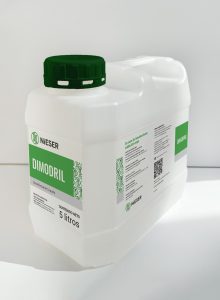DIMODRIL
DIMODRIL
Wide use liquid disinfectant based on quaternary ammonium salts

Ideal product to accompany a whole cleaning and disinfection process ensuring the final quality of the process.
Does not corrode metals, plastics, rubber, wood and others. Does not stain. Does not cause allergies or irritation.
Used as recommended, it is not toxic to humans or animals. Once diluted to the dosage of use, it is odorless and tasteless. Effective at different pH, being more active at alkaline pH and hot.
The product is easily diluted in water and alcohol at all recommended dilutions. It is intended for disinfection of implements and/or installations. Inhibits the growth of algae and fungi.
Agent: Adenovirus, Coronavirus, Paramyxovirus, Parvovirus, Reovirus, Escherichia coli, Salmonella gallinarum, Salmonella pullorum, Salmonella enteritidis, Salmonella typhimurium, Salmonella Heidelberg, Salmonella cholera suis, Staphylococcus spp, Streptococcus spp, Brucella abortus, Pasteurella multocida, Pasteurella haemolytica, Erysipelothrix spp, Avibacterium paragallinarum, Clostridium spp, Shigella spp, Aspergillus niger, Aspergillus flavus, Candida albicans.
Microorganism: Virus, Bacteria, Fungus, Yeast.
Affections: Avian Infectious Bronchitis, Bovine Viral Diarrhea, Diphtherovirus, Canine Distemper (Distemper), Avian Encephalomyelitis, Gumboro Disease, Marek’s Disease , New Castle Disease, Viral Swine Gastroenteritis, Avian Infectious Laryngotracheitis, Classical Swine Fever, EDS (EDS), Infectious Rhinotracheitis (TRT).
Target: Surfaces, Vehicle, Equipment, Hands, Drinking Water.
Species: Poultry, Swine, Cattle, Equine, Sheep, Canine, Feline, Human.
Quaternary ammonium-based disinfectant (Benzalkonium chloride: 15%)
Dosage: 1 L in 1,500 L of water for hand, facilities and incubation plant disinfection; 1 L in 3,000 L for drinking water disinfection.
Presentation 5 lts.
Vet Line
Economic practices for disease prevention in intensive animal husbandry.
With the incorporation of the biosecurity concept, Nieser products are indispensable in farms, hatcheries, feed processing plants, transport in general, sanitary barriers, sanitary customs for people, maternity wards, equipment, etc.
